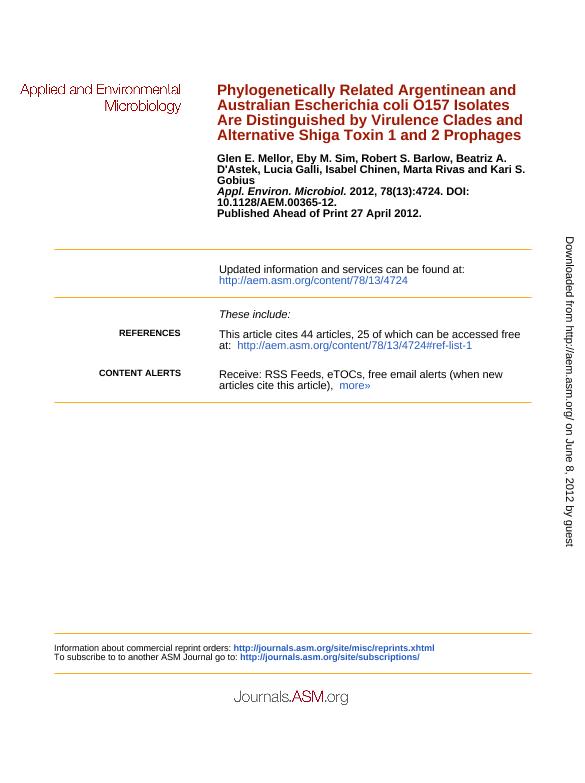Mostrar el registro sencillo del ítem
dc.contributor.author
Mellor, Glen E.
dc.contributor.author
Sim, Eby M.
dc.contributor.author
Barlow, Robert S.
dc.contributor.author
D'Astek, Beatriz A.
dc.contributor.author
Galli, Lucía

dc.contributor.author
Chinen, Isabel
dc.contributor.author
Rivas, Marta

dc.contributor.author
Gobius, Kari S.
dc.date.available
2019-07-02T14:21:58Z
dc.date.issued
2012-07
dc.identifier.citation
Mellor, Glen E.; Sim, Eby M.; Barlow, Robert S.; D'Astek, Beatriz A.; Galli, Lucía; et al.; Phylogenetically related Argentinean and Australian Escherichia coli O157 isolates are distinguished by virulence clades and alternative shiga toxin 1 and 2 prophages; American Society for Microbiology; Applied And Environmental Microbiology; 78; 13; 7-2012; 4724-4731
dc.identifier.issn
0099-2240
dc.identifier.uri
http://hdl.handle.net/11336/79014
dc.description.abstract
Shiga toxigenic Escherichia coli O157 is the leading cause of hemolytic uremic syndrome (HUS) worldwide. The frequencies of stx genotypes and the incidences of O157-related illness and HUS vary significantly between Argentina and Australia. Locusspecific polymorphism analysis revealed that lineage I/II (LI/II) E. coli O157 isolates were most prevalent in Argentina (90%) and Australia (88%). Argentinean LI/II isolates were shown to belong to clades 4 (28%) and 8 (72%), while Australian LI/II isolates were identified as clades 6 (15%), 7 (83%), and 8 (2%). Clade 8 was significantly associated with Shiga toxin bacteriophage insertion (SBI) type stx2 (locus of insertion, argW) in Argentinean isolates (P<0.0001). In Argentinean LI/II strains, stx2 is carried by a prophage inserted at argW, whereas in Australian LI/II strains the argW locus is occupied by the novel stx1 prophage. In both Argentinean and Australian LI/II strains, stx2c is almost exclusively carried by a prophage inserted at sbcB. However, alternative q933- or q21-related alleles were identified in the Australian stx2c prophage. Argentinean LI/II isolates were also distinguished from Australian isolates by the presence of the putative virulence determinant ECSP_3286 and the predominance of motile O157:H7 strains. Characteristics common to both Argentinean and Australian LI/II O157 strains included the presence of putative virulence determinants (ECSP_3620, ECSP_0242, ECSP_2687, ECSP_2870, and ECSP_2872) and the predominance of the tir255T allele. These data support further understanding of O157 phylogeny and may foster greater insight into the differential virulence of O157 lineages. © 2012, American Society for Microbiology.
dc.format
application/pdf
dc.language.iso
eng
dc.publisher
American Society for Microbiology

dc.rights
info:eu-repo/semantics/openAccess
dc.rights.uri
https://creativecommons.org/licenses/by-nc-sa/2.5/ar/
dc.subject
E. Coli
dc.subject
O157
dc.subject
Lspa-6
dc.subject
Phylogenetic
dc.subject.classification
Otras Ciencias Veterinarias

dc.subject.classification
Ciencias Veterinarias

dc.subject.classification
CIENCIAS AGRÍCOLAS

dc.title
Phylogenetically related Argentinean and Australian Escherichia coli O157 isolates are distinguished by virulence clades and alternative shiga toxin 1 and 2 prophages
dc.type
info:eu-repo/semantics/article
dc.type
info:ar-repo/semantics/artículo
dc.type
info:eu-repo/semantics/publishedVersion
dc.date.updated
2019-06-11T21:16:44Z
dc.journal.volume
78
dc.journal.number
13
dc.journal.pagination
4724-4731
dc.journal.pais
Estados Unidos

dc.journal.ciudad
Washington
dc.description.fil
Fil: Mellor, Glen E.. CSIRO Food and Nutritional Sciences; Australia
dc.description.fil
Fil: Sim, Eby M.. CSIRO Food and Nutritional Sciences; Australia
dc.description.fil
Fil: Barlow, Robert S.. CSIRO Food and Nutritional Sciences; Australia
dc.description.fil
Fil: D'Astek, Beatriz A.. Dirección Nacional de Instituto de Investigación. Administración Nacional de Laboratorio e Instituto de Salud “Dr. C. G. Malbrán”; Argentina
dc.description.fil
Fil: Galli, Lucía. Consejo Nacional de Investigaciones Científicas y Técnicas; Argentina. Dirección Nacional de Instituto de Investigación. Administración Nacional de Laboratorio e Instituto de Salud “Dr. C. G. Malbrán”; Argentina
dc.description.fil
Fil: Chinen, Isabel. Dirección Nacional de Instituto de Investigación. Administración Nacional de Laboratorio e Instituto de Salud “Dr. C. G. Malbrán”; Argentina
dc.description.fil
Fil: Rivas, Marta. Dirección Nacional de Instituto de Investigación. Administración Nacional de Laboratorio e Instituto de Salud “Dr. C. G. Malbrán”; Argentina
dc.description.fil
Fil: Gobius, Kari S.. CSIRO Food and Nutritional Sciences; Australia
dc.journal.title
Applied And Environmental Microbiology

dc.relation.alternativeid
info:eu-repo/semantics/altIdentifier/doi/http://dx.doi.org/10.1128/AEM.00365-12
dc.relation.alternativeid
info:eu-repo/semantics/altIdentifier/url/https://aem.asm.org/content/78/13/4724
Archivos asociados
